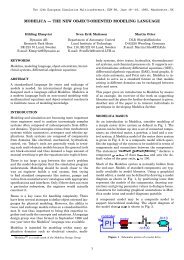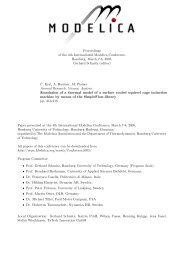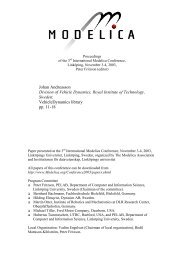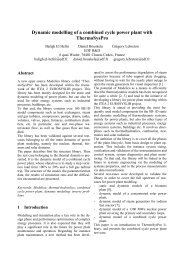Hilding Elmqvist, Hubertus Tummescheit and Martin Otter ... - Modelica
Hilding Elmqvist, Hubertus Tummescheit and Martin Otter ... - Modelica
Hilding Elmqvist, Hubertus Tummescheit and Martin Otter ... - Modelica
You also want an ePaper? Increase the reach of your titles
YUMPU automatically turns print PDFs into web optimized ePapers that Google loves.
H. <strong>Elmqvist</strong>, H. <strong>Tummescheit</strong>, M. <strong>Otter</strong> Object-Oriented Modeling of Thermo-Fluid Systems<br />
Density [kg/m3]<br />
1000<br />
100<br />
10<br />
0.1<br />
200<br />
1<br />
400<br />
1000<br />
Density as a Function of Enthalpy <strong>and</strong> Pressure<br />
x = 0<br />
2000<br />
Enthalpy [kJ/kg] 4000 1<br />
x = 1<br />
10<br />
Pressure [bar]<br />
100<br />
Figure 7: log.-plot of ρ(p,h) for IF97 water<br />
1000<br />
6.2 High Accuracy Ideal Gas Models<br />
Ideal gas properties cover a broad range of<br />
interesting engineering applications: air<br />
conditioning <strong>and</strong> climate control, industrial <strong>and</strong><br />
aerospace gas turbines, combustion processes,<br />
automotive engines, fuel cells <strong>and</strong> many chemical<br />
processes. Critically evaluated parameter sets are<br />
available for a large number of substances. The<br />
coefficients <strong>and</strong> data used in the <strong>Modelica</strong>_Media<br />
library are from [9]. Care has been taken to enable<br />
users to create their own gas mixtures with minimal<br />
effort. For most gases, the region of validity is from<br />
200 K to 6000 K, sufficient for most technical<br />
applications. The equation of state consists of the<br />
well-known ideal gas law p = ρ ⋅ R ⋅T<br />
with R the<br />
specific gas constant, <strong>and</strong> polynomials for the<br />
specific heat capacity cp (T ) , the specific enthalpy<br />
h(T ) <strong>and</strong> the specific entropy s ( T,<br />
p)<br />
:<br />
cp(<br />
T ) = R<br />
∑<br />
i=<br />
1<br />
⎛ a<br />
h(<br />
T ) = RT⎜<br />
⎜<br />
−<br />
⎝ T<br />
7<br />
a T<br />
i<br />
1<br />
2<br />
i−3<br />
+ a<br />
2<br />
log( T )<br />
+<br />
T<br />
7<br />
∑<br />
i=<br />
3<br />
⎛ a<br />
⎜ 1 a2<br />
s0<br />
( T ) = R<br />
⎜<br />
− − + a3<br />
log( T ) +<br />
2<br />
⎝ 2T<br />
T<br />
⎛ p ⎞<br />
s(<br />
T,<br />
p)<br />
= s −<br />
⎜<br />
⎟<br />
0(<br />
T ) Rln<br />
⎝ p0<br />
⎠<br />
i−3<br />
T b ⎞ 1 a + ⎟<br />
i<br />
i − 2 T ⎟<br />
⎠<br />
7<br />
∑<br />
i=<br />
4<br />
i−3<br />
T ⎞<br />
a + ⎟<br />
i b2<br />
i − 3 ⎟<br />
⎠<br />
The polynomials for h (T ) <strong>and</strong> s0 ( T ) are derived via<br />
integration from the one for cp(T ) <strong>and</strong> contain the<br />
integration constants b 1,b2<br />
that define the reference<br />
specific enthalpy <strong>and</strong> entropy. For entropy<br />
differences the reference pressure p0 is arbitrary, but<br />
not for absolute entropies. It is chosen as 1 st<strong>and</strong>ard<br />
atmosphere (101325 Pa). Depending on the intended<br />
use of the properties, users can choose between<br />
different reference enthalpies:<br />
1. The enthalpy of formation Hf of the molecule<br />
can be included or excluded.<br />
2. The value 0 for the specific enthalpy without Hf<br />
can be defined to be at 298.15 K (25 °C) or at 0<br />
K.<br />
For some of the species, transport properties are also<br />
available. The form of the equations is:<br />
⎛ ν ⎞<br />
B C<br />
lg⎜<br />
⎟ = A⋅<br />
lg(<br />
T ) + + + D<br />
k<br />
2<br />
⎝10<br />
⎠<br />
T T<br />
Bλ<br />
Cλ<br />
lg(<br />
λ)<br />
= Aλ<br />
⋅ lg(<br />
T ) + + + D 2 λ<br />
T T<br />
η = ν ⋅ ρ<br />
with the kinematic viscosity ν , dynamic viscosity<br />
η , thermal conductivity λ <strong>and</strong> parameters A,B,C,D<br />
<strong>and</strong> k. Note, though, that the thermal conductivity is<br />
only the “frozen” thermal conductivity, i.e., not<br />
valid for fast reactions.<br />
6.3 Ideal Gas Mixtures<br />
For mixtures of ideal gases, the st<strong>and</strong>ard, ideal<br />
mixing rules apply:<br />
h<br />
s<br />
mix<br />
mix<br />
( T ) =<br />
( T ) =<br />
nspecies<br />
∑<br />
i=<br />
1<br />
nspecies<br />
∑<br />
i=<br />
1<br />
h ( T ) x<br />
i<br />
⎛ p ⎞<br />
⎜ ⎟<br />
⎝ p0<br />
⎠<br />
( s ( T ) − R ln( y ) ) x − Rln⎜<br />
⎟,<br />
i<br />
i<br />
where the xi are the mass fractions, the Ri are the<br />
specific gas constants <strong>and</strong> the yi are the molar<br />
fractions of the components of the mixture. Most<br />
other properties are then computed just as for single<br />
species media. Dynamic viscosity <strong>and</strong> thermal<br />
conductivity for mixtures require interaction<br />
parameters of a similar functional form as the<br />
viscosity itself <strong>and</strong> are (not yet) implemented.<br />
For mixtures of ideal gases, three usage<br />
scenarios can be distinguished:<br />
1. The composition is fixed <strong>and</strong> is the same<br />
throughout the system. This means that a<br />
new data record can be computed by<br />
preprocessing the component property data<br />
that can be treated as a new, single species<br />
data record (assuming ideal mixing).<br />
2. The composition is variable, but changes in<br />
composition occur only through convection,<br />
i.e. slowly.<br />
3. The composition is variable <strong>and</strong> may<br />
change through reactions too, i.e.<br />
composition changes are possibly very fast.<br />
Case 1 <strong>and</strong> 2 above can be h<strong>and</strong>led within a single<br />
model with a Boolean switch, case 3 needs to extend<br />
from that model because usually a number of<br />
The <strong>Modelica</strong> Association <strong>Modelica</strong> 2003, November 3-4, 2003<br />
i<br />
i<br />
i

















